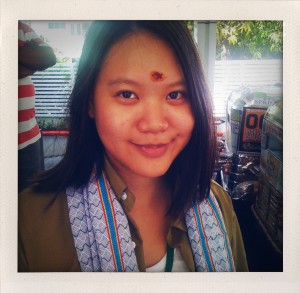We Have No Dungarees, Saar
Madras, India
There are slower ways of seeing India. On a buffalo. On a "two wheeler", a motorcycle, stacked to great heights with assorted luggage until you can't see what's in front of you. Or on foot, "by walk", like a sadhu with no clothes on.
We travelled by autorickshaw.
An autorickshaw isn't too bad an idea on paper: it is, after all, capable of hitting up to 50km per hour. Which would be comforting if our speedometer actually worked. Instead, ours wavered meekly several times per day, mostly settling for the number 65. How machines lie. I wouldn't even call our autorickshaw a machine — a primitive piece of equipment, yes, but machine, implying any form of mechanical achievement or efficiency, no.
We set off from Madras one hot morning, dressed to the nines. It was a good idea before flag-off, this brilliant idea we had of dressing just like a rickshaw wallah. The previous nights we had been in Pondy Bazaar every night, looking for various items to complete our get up. We'd planned to dress as Super Mario characters at first. The mustache and beret were no problem, the theatre costume company we'd checked out earlier had plenty of those things. They were initially designed for Roman centurion characters and other popular roles, such as various Hindu gods, but we could appropriate those items to create our Mario outfit. But the suspenders were impossible. Even the salesmen at Saravana Stores laughed at us when Karthik described what we wanted. "You mean you want dungarees, saar? They're so old-fashioned. You cannot find them in Madras. They're too old-fashioned, saar, we have no dungarees." If a Madras salesman tells you they are out of fashion, they are out of fashion. So we thought we'd dress like a rickshaw wallah instead.
Saravana Stores is a bit like Singapore's Mustafa Centre. Mustafa scores better on the "has all the crap you ever need to buy" front, but Saravana wins on the "has an entire section of the store dedicated to rickshaw men's uniforms" front. We skipped over like crazy firingis, trying out different types of singlets (who knew there were so many?); a variety of khaki shirts, and patterned lungis. A few hundred rupees later, we were in business.

The author dressed as a rickshaw wallah with a tilak.
We took off from our base in Kodambakkam High Road, much to the delight of the local press. I was interviewed several times, very likely because I was a girl with a tilak on her head, dressed like an autorickshaw man (thereby bending gender norms a little bit). I smiled nicely and fiddled with my lungi, and put on my best I am a foreigner accent. All was forgiven. Foreigners can do whatever the hell they want because we're all supposed to be crazy. Crazy enough to be driving a three-wheeler for 21 days continuously anyway.
Among the many questions posed to us by the Indian media, the one I could not answer was, "What do you hope to achieve by doing this? What is your intention?" Insanity has no intentions. It simply happens. Likewise, when I first read about the Rickshaw Challenge five years ago in Wired, I knew I had to go. The insanity took over and consumed me until I finally bit the bullet and went for it.
Where we would live, where we would spend our nights, how we would repair our auto when it broke down (and we knew it would break down at least once a day), I had no idea. Everyone else had booked the hotel package that came with the race, but we were too cheap adventurous for that. If we were going to see South India the way none of us had ever seen her before, we would do it the proper way. We would drive an auto everywhere and we would stay anywhere, as long as it was close to a TASMAC and a good breakfast.
With that policy of insanity and inebriation firmly in mind, we set off for the open road, cruising on the East Coast Road. It was one of the happiest moments of my life.